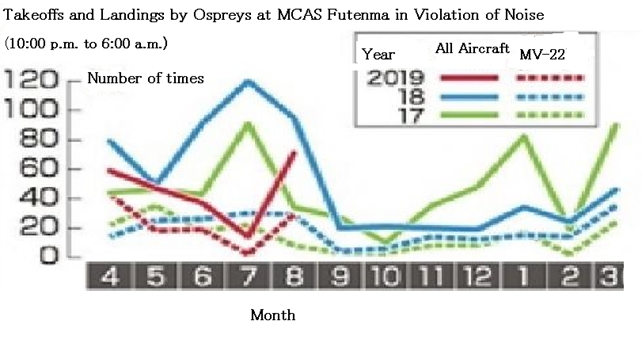Seven years after the deployment of MV-22 Ospreys to MCAS Futenma, night flights outside the agreed upon times increasing

Takeoffs and Landings by Ospreys at MCAS Futenma in Violation of Noise Agreement
October 1, 2019 Ryukyu Shimpo
It has been seven years since the MV-22 vertical-takeoff-and-landing-capable (VTOL) transport aircraft was deployed to MCAS Futenma in Ginowan. As part of measures taken to reduce noise pollution from aircraft (the noise pollution prevention agreement), flights are restricted from 10:00 p.m. to 6:00 a.m. the following morning.
Since 2017, the proportion of Osprey takeoffs and landings in violation of this agreement among all such flights has been gradually increasing. When flying at low altitude, the Osprey can output noise pollution at levels that exceed the 100 decibels produced by jet engines, and this causes even greater distress for Okinawans when these flights occur at night.
According to observations that have been conducted the Okinawa Defense Bureau (ODB) since 2017, the total number of takeoffs and landings from MCAS Futenma in violation of the agreement was 569 in 2017, 618 in 2018, and 228 so far in 2019, measured from April through August.
Among these flights, Ospreys accounted for 170 in 2017, and 224 in 2018. For the same five-month period in 2019, Osprey flights have already reached half of the total 2018 figure at 111. As a percentage of the total violating flights, it has gradually risen from 29.9% in 2017 to 36.1% in 2018 and 48.7% for the flights that have been measured so far in 2019.
Most of the Osprey flights in violation of the agreement occur between 10:00 p.m. and midnight. The majority of noise complaints such as “being unable to sleep due to noise” filed to the city police base hotline come from these flights. The total number of Osprey takeoffs and landing was 2,300 in 2017, 2,952 in 2018, and 1,098 so far in 2019.
In July, when some CV-22 Ospreys from Yokota Air Base (Tokyo) came to Kadena for training, there were fears that the aircraft would come to MCAS Futenma for refueling, further exacerbating the burden on local residents. At Futenma, the Air Force can perform “Hot-Pit” refueling that can be done without stopping the engines, which is not possible at Kadena.
(English translation by T&CT and Sam Grieb)
Previous Article:Japanese Should Stop Calling DRPK “Kita-Chosen”
Next Article:U.S. military still using land after its return; 342 unused bullets, field rations waste, and other garbage found on former NTA land
[Similar Articles]
- Takeoffs/landings at Futenma Air Station in 2020 reaches record high of 17,500 for the year
- Cause of U.S. military Osprey’s emergency landing at Oita Airport remains undisclosed
- Nighttime Osprey flights double, conflicting with claims of burden reduction
- U.S. military nighttime takeoffs/landings violate noise-prevention agreement, citizens complain
- Transferring training of Osprey aircraft to other places has no effect, while the total number of take-off and landing operations increases at Futenma
 Webcam(Kokusai Street)
Webcam(Kokusai Street)


